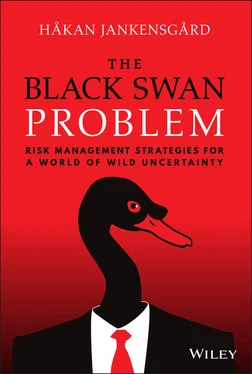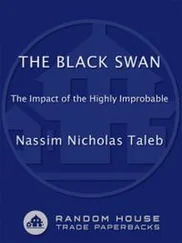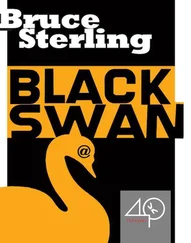We start out, however, by recapping some of the core themes in the Black Swan framework ( Chapter 1, ‘The Swans Revisited’). In this chapter, we take a fresh look at the question of what constitutes a Black Swan. We also revisit the issue of what kind of randomness we face as decision‐makers in the real world, as well as the crucial role of expectations. We establish the relative nature of Swans: players in the same industry can have very diverging expectations and are therefore likely to display different levels of preparation and vulnerability.
In Chapter 2(‘Corporate Swans’), we begin our exploration of what the Black Swan framework means for corporate management. I argue that it is the expectations of the firm's Board of Directors that is the correct perspective for determining what counts as a Black Swan. This has the interesting effect of increasing the number of Swans because of the structural information disadvantage the directors find themselves in as compared to the executive team. Even more troubling, the rate also goes up because the executives are a potential source of Black Swans. We go on to explore several other Swans that are specific to the corporate domain, over and above the ones generated by the natural world and complex systems at the level of society.
In Chapter 3(‘The Black Swan Problem’), we dive deeper into the question of how risk, and tail risk more specifically, relates to firm value. The risk of wipeout and strategy disruption provide economic arguments in favour of managing tail risk. Ultimately, though, we want to be able to demonstrate that managing tail risk produces benefits that are larger than the costs. This proves somewhat harder than expected, because when the probability of something goes towards zero – as they do with Black Swans – the cost of risk also tends towards zero. The conundrum is that when the cost of risk is near‐zero, there is little apparent justification for spending corporate resources on tail risk management. The second part of the Black Swan problem is the difficulty of mustering a proactive response to extreme events. A whole host of biases, both on the individual and organizational level, work against it.
In Chapter 4(‘Greeting the Swan’), we discuss the need to alter our attitude to randomness as a first basic step in developing a strategy for dealing with the Black Swan phenomenon. We also need to recognize that the resources and patience available for managing the risk associated with extreme events are very small. Running through this book is a persistent tension between tail risk management and economic efficiency. Another part of adapting our mindset to a world of wild uncertainty is to own up to the delicate matter that Black Swans are sometimes made closer to home by people we want to trust. The Board of Directors need to extend their Swan map to cover known company‐wreckers like acquisitions, derivative portfolios and, yes, the executive team.
In Chapter 5(‘Taming the Swan’), we arrive at the issue of how to make ourselves robust to wild uncertainty, to continue to survive and thrive even in much‐worse‐than‐expected scenarios. We dig deeply into the role of buffers and flexibility in achieving resilience, with particular emphasis on risk capital, a set of financial resources that absorbs shocks and ensures survival and strategy execution. Stress testing, I argue, is a particularly important, but currently under‐used, tool in the corporate battle against Black Swans. In them, we push resilience to the limits to learn about breaking points that can inform risk management strategies. The chapter contains extensive discussions on the role of models in the process of developing resilience. On the one hand, they help us see by reducing complexity and clarifying important mechanisms. On the other hand, they can make us blind to whatever is outside the model, creating a potential source of vulnerability.
In Chapter 6(‘Catching the Swan’), we learn about the concept of antifragility, which goes beyond resilience to identify things that actually benefit from disorder. This is where we fully explore the strategic implications of differences in expectations and levels of preparedness. Black Swans have the potential to decimate corporate strategies, which may open up opportunities for stronger competitors. We move past the idea of designing our risk management strategy exclusively by looking at our own vulnerabilities – we now incorporate the vulnerabilities of our closest competitors.
In Chapter 7(‘Riding the Swan’), we switch into a risk‐loving mode, searching for positive Black Swans. When our tinkering has yielded what is beginning to look like a beautiful, potentially world conquering strategy, the time has come to press the gas pedal to the floor. We go for maximum growth by pulling all the levers at our disposal, all the while tolerating huge amounts of risk. We reach the disconcerting conclusion that all the things that were undesirable in order to build resilience are now in high demand.
1 1Taleb, N. N., 2007. The Black Swan: The impact of the highly probable. Random House: New York.
THE AUTHOR WISHES TO express a heartfelt thanks to the following people for their feedback throughout the writing process:
Petter Kapstad
Stanley Myint
John Fraser
Vesa Hakanen
Ulrich Adamheit
Martin Stevens
Aswath Damodaran
Tomas Sörensson
Seth Bernström
Tom Aabo
Niclas Andrén
Jacob Pedersen
Carl Montalvo
CHAPTER ONE The Swans Revisited
THE BLACK SWAN OF the popular imagination is one that swoops down from a clear blue sky, creating massive disorder in a very short amount of time. We expect it to be sudden and dramatic. The archetypical Black Swan is perhaps the 9/11 attack on the twin towers in New York in 2001. Virtually nobody could have been able to imagine such a thing. It was simply not on the mental map that something like that should even exist. Yet it happened, and in a single stroke, the world was a different place. The path we were on changed. The attack led to a whole new security apparatus, the war on terror, and the war in Iraq, to mention but a few of its consequences.
Actually, the ‘out of the blue’ aspect is not part of the original framework. Some Swans cited by Taleb take years if not centuries to play out. According to Taleb, Black Swans have just three attributes, none of which refers to suddenness. First, they are highly improbable. Second, they are highly consequential. Third, they make perfect sense after the fact. 1 When people talk about Black Swans it is usually the first two aspects they focus on, as if the term were essentially shorthand for low probability high impact risks. Simplifying in this way is wholly consistent with the reason that the Black Swan problem exists in the first place, reflecting as it does our tendency to reduce the number of dimensions of the phenomenon before us down to something more tractable and convenient.
Equating Black Swans with ‘mere’ low probability high impact risk, however, is to do the concept significant injustice. In reality, the Black Swan framework is valuable because it represents an altogether different way of approaching the world. Taleb asks us to reconsider some of our core assumptions about the very nature of the randomness we face as decision‐makers and the inferences we make based on what we can observe. Furthermore, he brings our attention to the crucial role of expectations and attitudes in dealing with uncertainty. The problem, Taleb explains, is one of not being humble enough with respect to the limitations of our knowledge. If we believe the world consists of a certain kind of randomness and that we can have mastery over it, we may be in for some pretty bad surprises if those beliefs do not conform with reality. We can try to impose crisp and stylized ideas that appeal to our aesthetic sensibilities as much as we want, but the chaotic world we live in refuses to bend. This insistence on abstract beauty is what Taleb has in mind when he labels something as ‘Platonic’, after the famed Greek philosopher who saw loveliness in order and maintained that it could be superimposed on the messy reality we can observe with our senses (Taleb, 2007, p.19).
Читать дальше












